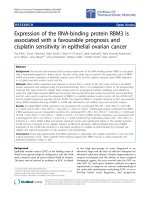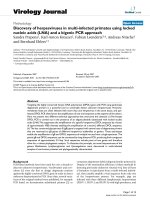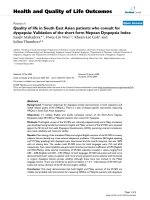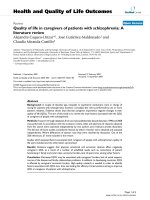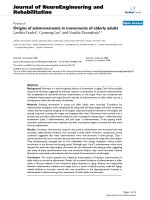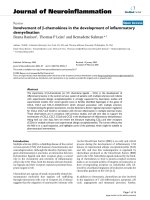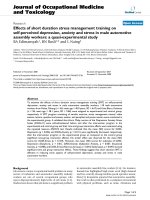báo cáo hóa học:" Loss of correction in unstable comminuted distal radius fractures with external fixation and bone grafting -a long term followup study" pdf
Bạn đang xem bản rút gọn của tài liệu. Xem và tải ngay bản đầy đủ của tài liệu tại đây (965.68 KB, 10 trang )
RESEARCH ARTICLE Open Access
Loss of correction in unstable comminuted distal
radius fractures with external fixation and bone
grafting -a long term followup study
PuttaKempa Raju
1
and Sunil Gurpur Kini
2*
Abstract
Over the years, management of complex distal radius fractures by closed me ans has often failed leading to late
collapse. We have chosen the principle of ligamentotaxis using external fixation and bone grafting in this study to
prevent late complications. Eighty one patients with complex distal radius fractures belonging to Type IV A, IV B, IV
C of Universal classification were treated with an AO external fixator between 1995 and 2001. Mean age group was
38. 47 years with longest follow up of 7 years. Bone grafting was done primarily in 20 patients and early grafting
(within 3 weeks) in 5 patients. Statistically significant differences were observed between the two groups(with or
without bone grafting) with respect to postoperative values of (rad ial length, radial tilt and volar tilt). Resu lts were
assessed based on Sarmientos criteria. 56 patients had excellent results, 9 had good results and 16 had poor
results. Late collapse with decreased radial lengt h was observed in 18 patients who did not undergo bone grafting.
Mean grip strength was 63 percent. Osteoarthritic changes were noted in 20 patients. We conclude that accurate
anatomic reduction is necessary for achieving good to excellent functional and cosmetic results. Bone grafting is
the mainstay of treatment in comminuted distal radius fractures along with fracture stabilisation.
Introduction
The management of complex distal radius fractures is
controversial. The approach to these fractures range
from cast immobilisation, extern al fixation, plating tech-
niques including fragment specific fixation. The need for
external fixation of these fractures to obtain accurate
anatomic reduction has increased the interest in these
devices. Late collapse of these fractures has been a sub-
ject of debate for l ast decades. Bone grafting for large
metaphyseal voids is well described entity to avoid col-
lapse and morbidity. Open placement of pins has led to
fewer complications including avoidance to injury to
superficial radial nerve and less damage to tendons and
soft tissues. Malunion and late deformity even after
external f ixation has bee n reported. Proper selection of
patients for e xternal fixation and timely bone grafting
has resulted in best possible functional and cosmetic
results. We present a long term followup of complex
distal radius fractures treated by external fixation and
discuss the results in terms of rest oration of anatomy
and function.
Materials and methods
The study conducted at Victoria hospital attached to
Bangalore Medical College and Research Institute com-
prised of 70 men and 11 women and the mean age was
38. 47 years. 57 of them were involved in heavy labour,3
were students and rest were involved in office work. The
mechanism of injury was motor vehicle accident in 69
patients, fall from a height in 12 patient s. 46 of them
involved the dominant hand and 35 the other. 4 of them
were open fractures-2 grade I,1 grade II and 1 grade IIIA.
Indications-Selection criteria included
1. A3, C2&C3-AO Classification
2. Frykmans V-VIII Fractures
1. Loss of position following closed reduction
3. Bilateral Colles’
4. Compound comminuted fractures
5. Unstable Fractures-
a) > 2 mm spread of fragments
b) Intra-articular extension with comminution
* Correspondence:
2
Tan Tock Seng Hospital, Singapore
Full list of author information is available at the end of the article
Raju and Kini Journal of Orthopaedic Surgery and Research 2011, 6:23
/>© 2011 Raju and Kini; licensee BioMed Central Ltd. This is an Open Access article distributed u nder the terms of the Creative Commons
Attribution License ( which permits unrestricted use, distribution, and reproduction in
any medium, provided the original work is prope rly cited.
c) > 10 deg. angulation
d) Ulnar neck fracture
e) Shortening > 10 mm.
Assessment-On arrival to the hospital a detailed his-
tory was elicited and associated injuries were docu-
mented. Standardised Anteroposterior and lateral
radiographs were taken and after thorough evaluation,
unstable comminuted fractures were enrolled into the
study. Majority of patients treated by external fixation
were of closed comminuted (85. 7%) and intraarticular
(100%) in nature. 67 patien ts reported to us immedi-
ately and 14 within 48 hours of trauma. External fixa-
tor was applied using the Shanz principle of
ligamentotaxis. 77 of them were operated immediately
and 4 of them were operated on days 2,3, 5 and 7 (loss
of initial reduct ion).
Technique- With the patient in supine position under
anaesthesia and tourniquet, the prepared e xtremity is
draped. Four pins were used 2 in the radius and 2 for
the second metacarpal. The proximal most pin for the
radius and the distal most pin in the metacarpal is
introduced first after predrilling. Open pin placement
avoids damage to the intrinsic muscles and tendons and
avoids eccentric pin placement. After precise pin appli-
cation the fixator bar is applied, fracture fragments
reduced by palmar tra nslation of the fragments with the
wrist in neutral position, distraction was applied and
fixator clamps tightened. Reduction was verified under
C arm and then the rest two pins inserted. Post opera-
tively antibiotics were used for 2 doses in closed and 3
days in open fractures.
Mobilisation of finger at Metacarpophalangeal and
Interphalangeal joints, forearm supination and pronation
movements and shoulder exercises were started from
the day after surgery. Regul ar followup visits were car-
ried every week. External fixator was removed after con-
firming radiological union at a mean of 8 weeks and
vigorous physiotherapy started.
Bone grafting was done in 25 patients via dorsal
approach in the following situations.
• Osteoporotic bone
• Metaphyseal voids
• High energy trauma in younger individuals
• Large gap s due to absorption of metaphyseal
fragments.
Bone graft was harvested f rom the iliac crest through
a limited approach. The grafts were packed tightly
through the fracture site. Anatomic reduction was
obtained by minim izing the articular incongruity to less
than 1 mm.
Results
The followup duration ranged from 38 months to 91
months with a mean o f 62 months. The functional eva-
luation of end results was done by the Gartland and
Werley’s point system and anatomical results by Sar-
miento’s criteria.
The followup examination included detailed question-
naire based on demerits system to assess the results. All
the patients were evaluated by the senior author. Statis-
tical analysis of data was done using Pearson coefficient
or chi square test. Grip strength was assessed using
using a dynamometer. The contralateral limb was used
as control. Reduced grip strength was noticed inpatients
who had increased dorsal tilt and decreased radial
length of more than 10 mm. 56 patients had excellent
results,9 good and 16 poor results. Late collapse was
noticed in 22 patients who did not undergo bone graft-
ing. The same was observed in osteoarthritic changes
secondary to late collapse. The presence of post trau-
matic arthritis in 20 patients were graded as per the
table (Table 1)
Arthritis in Radio carpal joints developed in 20 of 56
patients without bone grafting and none in the grafted
group (25 cases). In all these the articular incongruity
was more than 6 mm. Arthritis limited to distal radioul-
nar joint was seen in 3 patients. The occurrence of die
punch fragment adversely affected the late results. Die
punch fragments were reduced anatomically in all the
patients except in three patients and all of them devel-
oped residual radiocarpal incongruity. Although the resi-
dual articular incongruity frequently resulted in
posttraumatic arthritis, the minimal stepoff in severely
comminuted fractures in w hich the anatomical reduc-
tion and congruity was restored and maintained led to
significantly better overall results (Table 2).
Case 1 - Figure 1, Figure 2, Figure 3, Figure 4
Case 2 - Figure 5, Figure 6, Figure 7
Case 3 - Figure 8, Figure 9, Figure 10.
Discussion
80percentofaxialloadsatthewristaresupportedby
the distal end of the radius and 20 percent by the trian-
gular fibrocartilage and the distal end of the ulna[1].
The limitation of external fixation to achieve articular
Table 1 Grading of Radiocarpal arthritis
Grade Arthritis
0 No changes
I Minimal narrowing of joint space-medial/lateral in the
Radiocaroal joint
II Marked narrowing of joint space, osteophyte formation
III Severe narrowing of joint space, osteophyte formation, cyst
formation
Raju and Kini Journal of Orthopaedic Surgery and Research 2011, 6:23
/>Page 2 of 10
congruity in the comminuted intra-articular fractures of
the distal radius has been documented previously[2].
This could be because external fixation alone d oes not
expand crushed cancellous bone and cannot work with-
out soft tissue hinges [3].
Skeletal traction maintained by a ha lf frame external
fixator between the radius and second metacarpal bone
appears to provide appropriat e stabilization of the frag-
ments. External fixator provides stability and fixed trac-
tion, prevents shortening due to either bone loss or late
resorption of cancellous bone from the metaphysis. A
study by Sommerkamp et. al stated that the loss of four
millimeters of radial length in the dynamic-fixator group
over the course of treatment was significantly greater than
the one-millimeter loss in the static-fixator group [4].
Current concepts reflect the growing popularity of
external fixation of complex distal radius fractures
bec ause it provides easy accessibility of wound care and
it can be combined with secondary procedures like bone
grafting and skin coverage.
Age and sex incidence
Age group ranged from 20 yrs to 58 yrs with mean of
38. 47 yrs. Increased incidence of these fractures in
males(88. 46%) in our series (Cooneyet. al 11. 6%) espe-
cially in adults is attributed to high level of activity in
males and road traffic accidents(84. 61%) among riders
of two wheelers.
Type of fracture/Classification
Majority of fractures were closed(94. 23%). A ll fractures
were of Type IV Universal classification 2 Type IV A,
31 Type IV B, 19Type IV C.
Timing of fixator removal
Recommended duration of external fixation use varies
and s ometimes extends to between 8 and 12 weeks [5].
Until f ixato r removal, pat ients were followed up once a
Table 2 Articluar Incongruity grading
Grading Step off (in mm)
0 0-1
1 1-2
2 2-3
3>3
Figure 1 Case 1 Preoperative Radiograph - Anteroposterior and Lateral view.
Raju and Kini Journal of Orthopaedic Surgery and Research 2011, 6:23
/>Page 3 of 10
week. Average duration for removal was 8 weeks indi-
cated by radiological fracture union which was the main
criteria. In literature the duration of use of fixator
ranges from 8 to 12 weeks. Fair a nd Poor functional
results can be attributed to extended period of applica-
tion of external fixation in 4 patients.
Bone grafting
Bone grafting is the mainstay o f treatment in any distal
radius fractures with large metaphyseal void which are
prone to collapse at later date. Cancellous bone grafts
harvestedfromtheiliacbonereducedtheperiodof
external fixation and supported the articular surface.
Packing cancellous bone chips into these comminuted
fractures increased the rigidity of reduction fourfold [6].
Bone grafting was carried out either primarily or secon-
darily and also on the acceptability of patients for bone
grafting. Bone grafting improved the anatomical
alignment of the fragments and the articular congruity
and allowed early mobilization of the wrist and fingers.
The external fixation does not provide the absolute sta-
bility to maintain the comminuted intrarticular frac-
tures. It takes a longer time for the fracture gap to be
filled by new bone formation. In study of Overggard et.
al over a seven-year follow-up, seventeen (30 per cent)
of their fifty-six patients had radiographic evidence of
osteophytes and eight patients (14 per cent) had
advanced radiographic changes [7]. In our study late
collapse was not noticed in patients who underwent
bone grafting after 7 year followups. By pushing the
grafts towards the distal articular surface many of the
die punch fragments which cannot be reduced by liga-
mentotaxis alone can be adequately lifted, reduced and
supported to achieve congruent articular surface [8].
Bone grafts supply an interosseous distension force
which enhances the ligamentotaxis and helps to line up
Figure 2 Case 1 Postoperative Radiograph - Anteroposterior and Lateral view.
Raju and Kini Journal of Orthopaedic Surgery and Research 2011, 6:23
/>Page 4 of 10
the juxtaarticular bone fragments to maintain the integ-
rity of the distal radius.
Combination of ligament otaxis and cancellous bone
grafting produced excellent clinical and radiological
results. As Gr een pointed out good functional re sults
usually follow good anatomical results. Our met hod uti-
lized both biological and mechanical effects of bone
grafting enabling us to reduce the duration of external
fixation and to obtain internal trabecular healing. Tight
packing w ith bone grafts produces better load bearing,
fills space and stretches and tightens the residual perios-
teum. Then compressive strength of bone tissue is
proportional to t he square of the appare nt density. So
highly compact cancellous bone grafts provides good
stability in metaphyseal fractures.
Anatomical results
We believe that it is th e quality of reduction that deter-
mines the clinical outcome. Thus the aim of external
fixation is to obtain and maintain an accurate anatomic
reduction of the fracture fragments and to prevent col-
lapse, malunion, deformity and late osteoarthritis. Main-
tenance of radial length results in good functional
outcome. The average radial height in AP view is 11 to
14 mm and a height of less than 4 mm corresponds to
Figure 3 Case 1 Radiograph (Anteroposterior view) at 7 year
followup.
Figure 4 Case 1 Radiograph (Lateral view) at 7 year followup.
Raju and Kini Journal of Orthopaedic Surgery and Research 2011, 6:23
/>Page 5 of 10
poor Haddad et. al in his study of 43 patients showed
that all but two of the patients (5%) had a volar tilt of
up to 16°, the radial length was restored in 77% and
excessively shor tened by 3-4 mm in 9 patients (23%) [9].
Leung et. al in his series showed loss of radial a rticular
angle (mean 2. 2 degrees) after removal o f the external
fixator[10]. In our series in 95% of cases, radial length of
more than 6 mm was maintained. Decrease in the excel-
lent functional results with respect to the maintenance
of radial length of more than 6 mm is due to the non
cooperation of p atients for physiotherapy and longer
periods of immobilisation. In our series restoration of
the normal v olar tilt in 90% of cases resulted in excel-
lent anatomical result. The excessive dorsal tilt produces
a dinner fork deformity and decreases the range of pal-
mar flexi on and also causes midcarpal instability due to
changes in l oad distribution. The collapse of the articu-
lar surface was not encountered in the dorsal angula-
tions in our series as the patients were not allowed to
perform extension for an additional 2 weeks after exter-
nal fixator removal.
Range of movements
Most patients regained good range of motion of wrist
and forearm all obtained normal finger movements.
Inspite of satisfactory reduction in 2 cases, persistent
wrist stiffness was encountered. This limitation of joint
motion is well tolerated by patients as the majority of
hand tasks can be accomplished with 70% of maximal
range of wrist movements which is revealed in this
study. For routine functional activities we require 35
degree of dorsiflexion and 10 degree of palmar flexion
of the wrist has been achieved in all the cases in the
study. No other method appears to be technically simple
and to give such excellent results.
Demerits
Posteromedial fragments, Indirect control of fragments,
No accurate reduction of intraarticular fragments,
Excessive distraction. Reduction and maintenance of
reduction is more difficult using bridging external fixa-
tion beca use there is indirect control of the distal frag-
ment, which depends on ligamentotaxis; this may not be
successful in restoring the volar tilt or the radial length
[11]. Difficulty in achieving volar tilt also may be due to
the fact that the stout palmar radiocarpal ligaments
reach maximum length before the z-shape dorsal liga-
ments, preventing the latter from pulling the dorsal
aspect of the distal end of the radius into its normal pal-
mar inclination[12]. Considerable transfer of load onto
the ulna occurs with progressive dorsal angulation of
the distal end of the radius [13].
Complications
Tissue perforation (n = 2), Pin tract infection (n = 2 ),
Pin loosening (n = 3), bending and breaking of pins
(n = 3), Loss of r eduction (n = 3), Stress fractures
(n = 2), Inflammatory reactions (n = 4), Osteolysis of
cortices (n = 3), Spontaneous pullout of pins (n = 2),
Figure 5 Case 2 Preoperative Radiograph Anteroposterior and
Lateral view.
Figure 6 Case 2 Immediate Postoperative Radiograph
Anteroposterior and Lateral view.
Raju and Kini Journal of Orthopaedic Surgery and Research 2011, 6:23
/>Page 6 of 10
Figure 7 Case 2 Radiograph at 7 year followup. Anteroposterior and Lateral view.
Figure 8 Case 3 Preoperative Radiograph Anteropsterior and Lateral view.
Raju and Kini Journal of Orthopaedic Surgery and Research 2011, 6:23
/>Page 7 of 10
Figure 9 Case3 Postoperative Radiograph (Anteroposterior and Lateral view).
Figure 10 Case 3 Radiograph at 7 year followup Anteroposetrior and Lateral view.
Raju and Kini Journal of Orthopaedic Surgery and Research 2011, 6:23
/>Page 8 of 10
Neuroma of sensory branch of radial nerve(n = 2),
Reflex sympathetic dystrophy ( n = 3), Wrist stiffness (n
= 3), Rupture of EPL tendon(n = 1), Osteoarthritis of
wrist(n = 2).
Loss of reduction was seen in 3 patients only that
confirms to previous studies, which show that external
fixation effectively maintains the reduced position [14].
Restriction of movements at the wrist has been attrib-
uted to the extended period of application of external
fixation and improper physiotherapy and also du e to
associated injuries in the ipsilateral limb which inter-
fered with the physiotherapy. Use o f open pin insertion
technique with a predrilled system has reduced the
injury to both tendon and nerves. Radial sensor nerve is
generally not at risk when pins are placed 10 cm proxi-
mal to the radial styloid process by this technique. Open
pin placement and pin insertion with sharp drill bits and
improved fixation with better thread design and inser-
tion of pins at an angle of 60 degrees to each other
increased the purchase of pins in t he bone and
decreased complications like pin bending, loosening and
breakage. Papadonikolakis et. al in their study concluded
that more than 5 mm of wrist istraction increases the
load required for the flexor digitorum superficialis to
generate MCP joint flexion for the m iddle, ring, and
smal l finge rs. For the index finger, however , as much as
2 mm of wrist distraction significantly increases the load
required for flexion at the MCP joint[15].
Complex distal radius fractures pose a s ignificant
challenge to the practicing surgeon because of the
inherent tendency to collapse resulti ng in malunion,
deformity. loss of function and late osteoarthritis. Fair
and poor results were attributed to associated injuries
and extended period of application of external fixator.
Lunate fragments which could not be reduced by
external fixation required open reduction, fixation with
K wires and bone grafting. Ulnar styloid process frac-
tures were not actively treated in this study. Late col-
lapse of the articular surface led to early arthritis. Bone
grafting should be performed to obtain good articular
congruity and to prevent deformity. Although AO
external fixator provides absolute rigidity and stability,
restoration of original palmar tilt could not be
achieved in all cases despite maintaining radial length
and radial. The restoration of palmar tilt requires mul-
tiplanar ligamentotaxis or a pin in the dorsal fragment.
Majority regained more than 63 percent of grip
strength. It is decreased in patients with increased
radial tilt, associated injuries and prolonged immobili-
sation. The final outcome of functional results in
complex distal radius fractures depends on patient
selection, fracture morphology, obtaining accurate
reduction and maintaining it by external o r internal
fixation, bone grafting inpatients with large
metaphyseal void, patients compliance towards phy-
siotherapy and associated injuries.
Author’s Information
PuttaKempa Raju M. B. B. S, D. (Orth), M. S(Orth)
Department of Orthopaedics, Bangalore Medical Col-
lege and Research Institute, Bangalore, India
SunilGurpurKiniM.B.B.S,M.S(Orth),D.N.B
(Orth), M. Ch(Orth), M. R. C. S(Glasg),
M. R. C. S(Edin), MNAMS, Dip. SICOT Tan Tock
Seng Hospital, Singapore
Author details
1
Victoria Hospital, Bangalore Medical College and Research Institute,
Bangalore, India.
2
Tan Tock Seng Hospital, Singapore.
Authors’ contributions
PKR was the main operating surgeon in all cases and follow up of the cases.
GSK was involved in maintaining the records of the patients, review of
literature and writing up the paper. All authors read and approved the final
manuscript.
Competing interests
The authors declare that they have no competing interests.
Received: 4 July 2010 Accepted: 21 May 2011 Published: 21 May 2011
References
1. Palmer AK: The Distal Radioulnar Joint. Anatomy, Biomechanics, and
Triangular Fibrocartilage Complex Abnormalities. Hand Clin 1987, 3:31-40.
2. Rogachefsky RA, Lipson SR, Applegate B, et al: Treatment of severely
comminuted intraarticular fractures of the distal end of the radius by
open reduction and combined internal and external fixation. J Bone Joint
Surg 2001, 83(A):509-519.
3. Arora J, Malik AC: External fixation in comminuted, displaced intra-
articular fractures of the distal radius: is it sufficient. Arch Orthop Trauma
Surg 2005, 125:536-540.
4. Sommerkamp TG, Seeman M, Silliman J, et al: Dynamic external fixation of
unstable fractures of the distal part of the radius. A prospective,
randomized comparison with static external fixation. J Bone Joint Surg
1994, 76-A:1149-1161.
5. Cooney WP III, Linscheid RL, Dobyns JH: External fixation for unstable
Colles fractures. J Bone Joint Surg 1979, 61-A:840-845.
6. Kinninmonth A, Evans JH, Leung PC: A biomechanical study of
comminuted distal radial fractures to asses the stabilizing effect of
primary bone grafting. The Hong Kong Orthopaedic Association 7th annual
scientific congress 1987.
7. Soren Overgaard, Soren Solgaard: Osteoarthritis after Colles’ Fracture.
Orthopaedics 1989, 12:413-416.
8. Riggs S, Cooney W: External fixation of complex hand and wrist fractures.
J rauma 1983, 23:332-336.
9. Haddad M, Rubin G, Soudry M, Rozen N: External fixation for the
treatment of intra-articular fractures of the distal radius: short-term
results. Isr Med Assoc J 2010, 12(7):406-9.
10. Leung KS, Shen WY, Leung PC: Ligamentotaxis and bone grafting for
comminuted fractures of the distal radius. J Bone Joint Surg 1989, 71-
B(5):838-842.
11. Hayes AJ, Duffy PJ, McQueen MM: Bridging and non-bridging external
fixation in the treatment of unstable fractures of the distal radius. A
retrospective study of 588 patients. Acta Orthopaedica 2008,
79(4):540-547.
12. Bartosh RA, Saldana MJ: Intraarticular Fractures of the Distal Radius: A
Cadaveric Study to Determine if Ligamentotaxis Restores Radiopalmar
Tilt. J Hand Surg 1990, 15A:18-21.
13. Short WH, Palmer AK, Werner FW, Murphy DJ: A Biomechanical Study of
Distal Radial Fractures. J Hand Surg 1987, 12A:529-534.
Raju and Kini Journal of Orthopaedic Surgery and Research 2011, 6:23
/>Page 9 of 10
14. Kapoor H, Agarwal A, Dhaon B: Displaced intraarticular fractures of distal
radius: a comparative evaluation of results following closed reduction,
external fixation and open reduction with internal fixation. Injury 2000,
31:75-79.
15. Papadonikolakis A, Shen J, Garrett JP, Davis SM, Ruch DS: The effect of
increasing distraction on digital motion after external fixation of the
wrist. J Hand Surg 2005, 30A:773-779.
doi:10.1186/1749-799X-6-23
Cite this article as: Raju and Kini: Loss of correction in unstable
comminuted distal radius fractures with external fixation and bone
grafting -a long term followup study. Journal of Orthopaedic Surgery and
Research 2011 6:23.
Submit your next manuscript to BioMed Central
and take full advantage of:
• Convenient online submission
• Thorough peer review
• No space constraints or color figure charges
• Immediate publication on acceptance
• Inclusion in PubMed, CAS, Scopus and Google Scholar
• Research which is freely available for redistribution
Submit your manuscript at
www.biomedcentral.com/submit
Raju and Kini Journal of Orthopaedic Surgery and Research 2011, 6:23
/>Page 10 of 10
